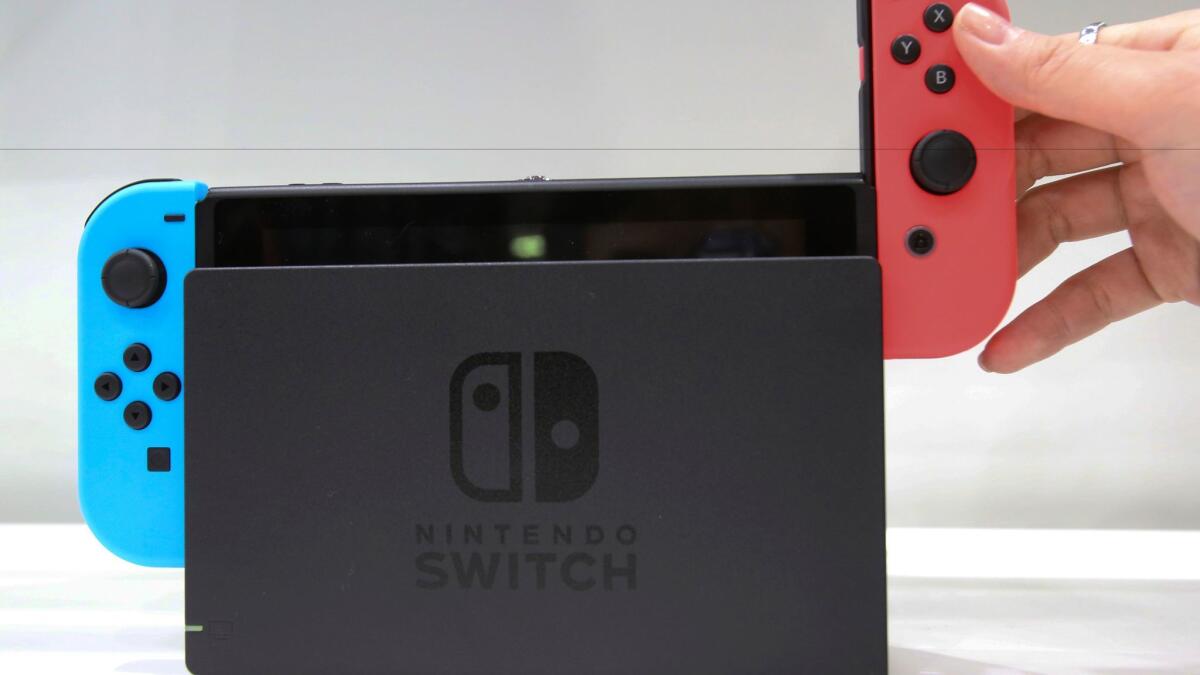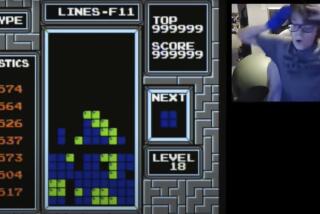Nintendo’s Switch re-imagines the home console for the mobile era

Not since the debut of its original Nintendo Entertainment System has the Japanese company released a home video game console with as much potential to shake up how we play as the Nintendo Switch, which is out Friday.
Thirty years ago, Nintendo reinvented the video game medium. Not only did the NES lead to such genre-defining interactive entertainment as “Super Mario Bros.” and “The Legend of Zelda,” but it also liberated games from the arcade and brought them to the American living room.
For the record:
5:05 p.m. April 25, 2024An earlier version of this post spelled Game Boy as Gameboy.
Where they could increasingly be played for hours, days, weeks, months. Rather than intense, cliffhanger-like action that demanded the next 25 cents, home games had pace, tempo and rudimentary stories. They were also accessible — no obscenely pricey home computer or trip to a teenage-infested arcade needed.
The Switch takes that livability to another level. It is a home video game console that’s connected to a television. But it’s also a hand-held device designed for ultimate mobility. And at least one of its games barely requires the use of a screen at all.
The Switch doesn’t tell you how, or where, it should be played; the Switch adapts to suit to your needs. In many ways, it’s the antidote for the the toy-like Wii U, which used a plastic, tablet-like controller and, in hindsight, misjudged our appetite for multiple screens. Selling just 13.6 million units since its launch in 2012, the Wii U has the unfortunate distinction of being the poorest-selling Nintendo console ever.
The Switch, then, is the device with which Nintendo hopes to reverse its fortunes.
It looks far less like a child’s plaything and is arguably the first major video game console to prioritize user convenience, down to detachable controllers. When attached to the Switch, they give it the feel of a hand-held game machine; apart they become two mini individual controllers.
Slip the Switch into a dock connected to your television, and it acts as a traditional video game console. Disconnect it, and the Switch instantly becomes a touch-screen-enabled tablet for gaming on the go.
Want to play with a friend at a coffee shop? The Switch makes that possible. Want to fuel insomnia and play into the early-morning hours in your bed, or play on the couch, staring at the TV? The Switch makes all that possible too.
As an idea, there is no other video game console on the market today that feels as in tune with how we live and play.
Imagine a Game Boy or an iPad, but one with the power to run a deeply expansive game such as the new “The Legend of Zelda: Breath of the Wild,” the sort of game that previously required a PC or TV-connected console.With such a massive game made portable, the long-held norm of being tethered to a couch feels outdated.
The Switch may not fit in our pockets, but it slides easily into our mobile and tablet-obsessed age. After a week with the Switch, it’s easy to look forward to a day when it’s possible to jump from “Breath of the Wild” to, say, an email app or Netflix.
And that gets to the heart as to what is currently wrong with the Switch: It needs things for the user to do. Concepts and reality are two different things. And for all its impressive tech, the Switch is currently more theory than actuality.
The console has two major hurdles: to convince hardcore gamers that the Switch can cater to their high-powered whims, and to convince casual players that the Switch is better than a cellphone or tablet. “The Legend of Zelda: Breath of the Wild” immediately makes a case for the former, as it re-imagines the fantasy franchise as a more sophisticated, yet never overwhelming, free-flowing adventure.
But to become a must-own system, the Switch needs more games, more apps and more connectivity.
At launch, the only must-own title for the $299 Switch is the $60 “Breath of the Wild.” And as with any piece of new tech, there are also some hidden costs; owners will want to invest in a microSD card to boost the console’s low memory as well as potentially an USB-C cord or additional charger to facilitate gaming away from home.
The cute — and freakishly weird — party game “1-2 Switch” is worth investigating despite its $50 price tag. The title proves that Nintendo’s army of developers remain as goofy as ever, and its selection of mini-games utilizes the Switch’s detachable controllers to clever but gimmicky results that emphasize movement and interaction and de-emphasize the screen.
Some games are simple and straightforward. Others are downright insane, such as games that asks players to mimic milking a cow (you squeeze the controller buttons as if they’re udders and swipe down) or cradle the controller like a baby and rock it to sleep.
Although these little diversions may not have long-term appeal, they feel like a win, for the Switch’s versatility invites developers to get creative. And if Nintendo ultimately creates a robust online store, complete with games and apps that utilize the touch-screen as well as the controllers, the Switch could easily become a must-own tablet.
For now, however, the Switch is all “Zelda,” all the time, and Nintendo hasn’t exactly been forthcoming regarding non-gaming frontiers for the device. But as long as Nintendo continues to lead us in unexpected — and, more important, accessible — terrain, the Switch appears a safer bet than the Wii U.
So, let’s go milk some virtual cows.
Follow me on Twitter: @toddmartens
More to Read
The biggest entertainment stories
Get our big stories about Hollywood, film, television, music, arts, culture and more right in your inbox as soon as they publish.
You may occasionally receive promotional content from the Los Angeles Times.







